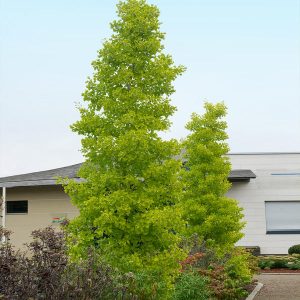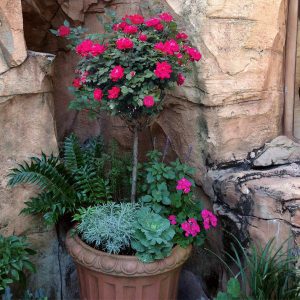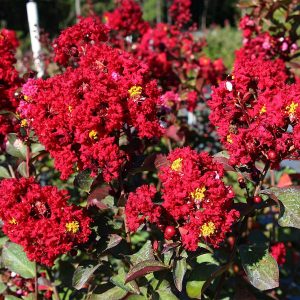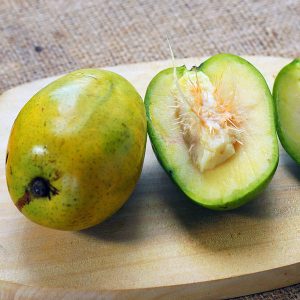Honeycrisp apple trees are known for bearing unique apples with a crisp bite and sweet, tart flavor. Typically grown in cooler climates, this tree is perfect for the gardener located in the Midwest and Northern regions of the United States.
Apples are the most popular fruit and there is hardly an adult or child that does not like apples. Not many people like sour apples however, so particularly with children, sweetness is the first thing to consider in an eating apple. Some apples are rather soft and bland, or at the other extreme hard and difficult to bite into for small children. Honeycrisp solves all these problems. The Honeycrisp Apple is a beautiful rich red color with yellow or green flecks. This apple will usually ripen in September and keep stored in a cool place for at least three months. So you can store and eat your entire crop with nothing going to waste. Besides being deliciously sweet, it has a little acidity to make it tasty, and although crisp and crunchy it is not hard to bite. It has high juice content and that juice is released in the mouth when bitten into. No wonder this has become a huge success in grocery stores, so imagine what your own tree-ripened fruit will taste like.

Choosing an apple variety to grow can be tricky. An important thing to consider is where you live. Some apples do well in warm or hot areas, other need colder conditions. If you live in very cold areas you need to be sure that the apple you choose will survive and do well with harsh winters and cooler summers. Honeycrisp is the ideal apple for northern states. This apple is hardy all the way to minus 400F, so even if you live in zone 3 you can successfully grow this tree and bring beautiful apples into your home right from the garden. It needs to be near another apple tree for pollination, but most varieties of apple will pollinate Honeycrisp. Even crab-apples will do this, so if you have any apples trees nearby you probably will not need to plant a second variety.
Minnesota is one of the coldest states in the Union. Most of it is in zone 3 and only in the south does it become zone 4. It is also an agricultural state and apples are an important crop. So since the 1930’s the University of Minnesota has been breeding apples to develop new varieties suitable for cold regions. They tested thousands of plants grown from seed and in 1991 they released a new variety that proved to be a sensation. This was Honeycrisp and it has become one of the most popular and widely grown apples. It is considered to be perhaps the greatest new apple variety released for many years.
The Honeycrisp Apple tree is hardy in zones 3 to 8 which makes it one of the hardiest apple varieties available. Always plant your Honeycrisp Apple tree in a sunny location. It will grow best in a well-drained soil and prefer a slightly sandy soil to one with a lot of clay. If you have clay soil, add plenty of rich organic material to it and grow your tree on a raised mound to give better drainage.
Apples trees are grown by grafting a stem of the correct variety onto the root system of a special apple grown only for this purpose. This is a skilled operation and must be done by experts. It is also very important that the tree used for the grafted stems really is a true Honeycrisp Apple and so only specialized nurseries can create these trees. Trees that do not develop strongly are sold cheaply, so beware of buying cheap trees which will not become sturdy and healthy apple trees.
When planting you tree, prepare the soil well with rich organic material. Dig a hole three times as wide as the pot. If you are planting in winter shake the soil from the roots and spread them out evenly around the hole. If you are planting a tree in leaf, make a cut an inch deep with a sharp knife from top to bottom of the root-ball at 3 or 4 places around the roots. This will encourage new roots to spread out from the tree. Replace most of the soil, keeping your tree at the same depth it was in the pot. Do not cover the ‘kink’ you will see low down on the trunk which was where the tree was grafted. Fill the hole with water and when it has drained away replace the rest of the soil. Apply mulch over the root-zone, leaving the area against the trunk free of the mulch. Keep your tree well watered especially during the summer months.
Apple trees need pruning and training from the beginning of their life with you. Plan to develop a tree with a central stem and side branches radiating out almost horizontally. Use string tied to stones to pull the branches down while they are young. Upright branches can easily break when the trees are older and your tree will be damaged, so start training early. It only takes a little time. Older trees should be trimmed to control their height.
When young your Honeycrisp Apple tree will produce a good crop of large apples. As it becomes older it will produce more and more fruit, so if you see a big crop of baby apples it is best to remove some while they are still small so that the ones that remain will become larger. Otherwise you will have a large harvest of very small apples, which is not ideal.









